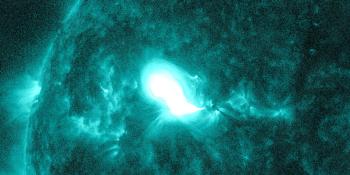Viewing archive of Friday, 20 September 2002
Solar activity report
Any mentioned solar flare in this report has a scaling factor applied by the Space Weather Prediction Center (SWPC). Because of the SWPC scaling factor, solar flares are reported as 42% smaller than for the science quality data. The scaling factor has been removed from our archived solar flare data to reflect the true physical units.
Report of Solar-Geophysical Activity 2002 Sep 20 2200 UTCPrepared by the NOAA © SWPC and processed by SpaceWeatherLive.com
Joint USAF/NOAA Report of Solar and Geophysical Activity
SDF Number 263 Issued at 2200Z on 20 Sep 2002IA. Analysis of Solar Active Regions and Activity from 19-2100Z to 20-2100Z Solar activity was moderate. New Region 126 (S24E62)
produced two M-class flares this period. Both were M1/Sf flares, at
20/0512Z and 0928Z, and both were accompanied by minor centimetric
bursts. Limb proximity makes it too difficult to accurately assess
Region 126's complexity, but initial measurements indicate a D type
group with 200 millionths of white light areal coverage. Region 119
(S14W24) continues to grow and the delta configuration is now more
pronounced. Despite this region's moderate complexity, flare output
has been nothing more than occasional minor C-class flares. Early in
the period, a large CME was observed, originating along a filament
channel near S30E12. The ejecta does not appear earthward directed.
New Regions 127 (S14E19) and 128 (N11E63) were numbered today.
Region 127 is in close proximity to Region 122 (S18E21), but the
consensus is that these are separate regions.
IB. Solar Activity Forecast
Solar activity is expected to continue
at low to moderate levels. Low M-class flares are possible from
Regions 119 and 126.
IIA. Geophysical Activity Summary 19-2100Z to 20-2100Z
The geomagnetic field was quiet to unsettled. Solar wind speed began
the period near 700 km/s following the arrival of a CME earlier
yesterday. However, a weak IMF with sustained northward Bz offset
any significant impact on the geomagnetic field.
IIB. Geophysical Activity Forecast
The geomagnetic field is
expected to remain at quiet to unsettled levels for the next three
days.
III. Event Probabilities 21 Sep to 23 Sep
| Class M | 50% | 50% | 50% |
| Class X | 05% | 05% | 05% |
| Proton | 05% | 05% | 05% |
| PCAF | green | ||
IV. Penticton 10.7 cm Flux
Observed 20 Sep 164 Predicted 21 Sep-23 Sep 165/160/160 90 Day Mean 20 Sep 178
V. Geomagnetic A Indices
Observed Afr/Ap 19 Sep 011/013 Estimated Afr/Ap 20 Sep 006/010 Predicted Afr/Ap 21 Sep-23 Sep 008/012-008/010-008/010
VI. Geomagnetic Activity Probabilities 21 Sep to 23 Sep
| A. Middle Latitudes | |||
|---|---|---|---|
| Active | 20% | 15% | 15% |
| Minor storm | 05% | 05% | 05% |
| Major-severe storm | 01% | 01% | 01% |
| B. High Latitudes | |||
|---|---|---|---|
| Active | 25% | 20% | 20% |
| Minor storm | 05% | 05% | 05% |
| Major-severe storm | 01% | 01% | 01% |
All times in UTC
Latest news
Latest forum messages
AR 3906 8>500 meV 23Filaments and prominences 561Suggestion - Can admins automatically generate "official" AR topic threads as the regions appear and are numbered? 2Comment limitation 6
More topicsSupport SpaceWeatherLive.com!
A lot of people come to SpaceWeatherLive to follow the Sun's activity or if there is aurora to be seen, but with more traffic comes higher server costs. Consider a donation if you enjoy SpaceWeatherLive so we can keep the website online!

Space weather facts
| Last X-flare | 2024/11/06 | X2.39 |
| Last M-flare | 2024/11/23 | M1.1 |
| Last geomagnetic storm | 2024/11/10 | Kp5+ (G1) |
| Spotless days | |
|---|---|
| Last spotless day | 2022/06/08 |
| Monthly mean Sunspot Number | |
|---|---|
| October 2024 | 166.4 +25 |
| November 2024 | 144.1 -22.3 |
| Last 30 days | 158.7 +10.9 |


